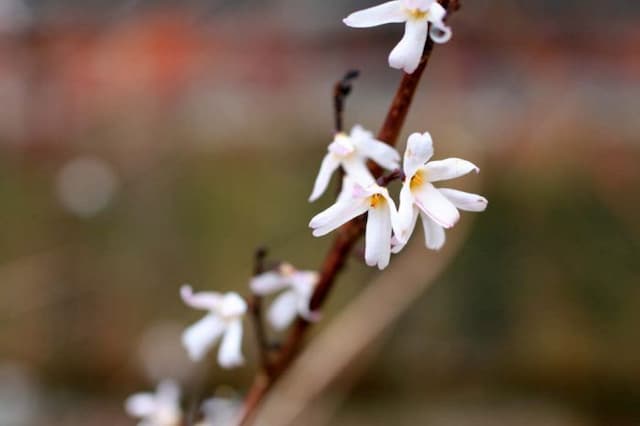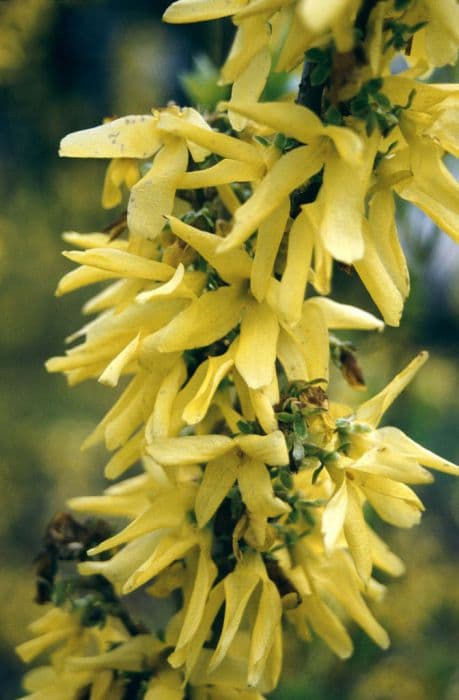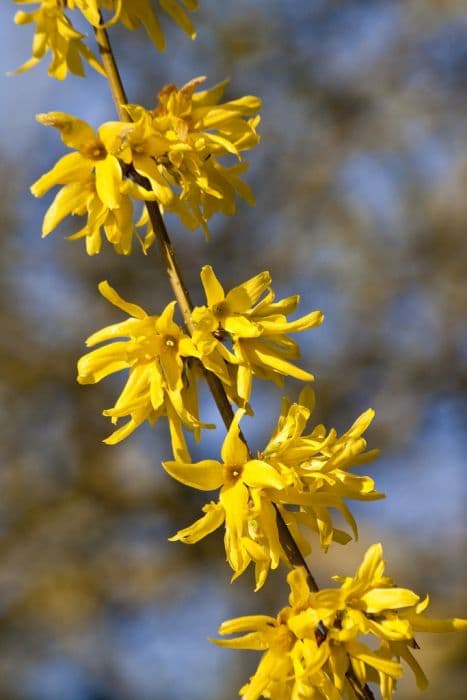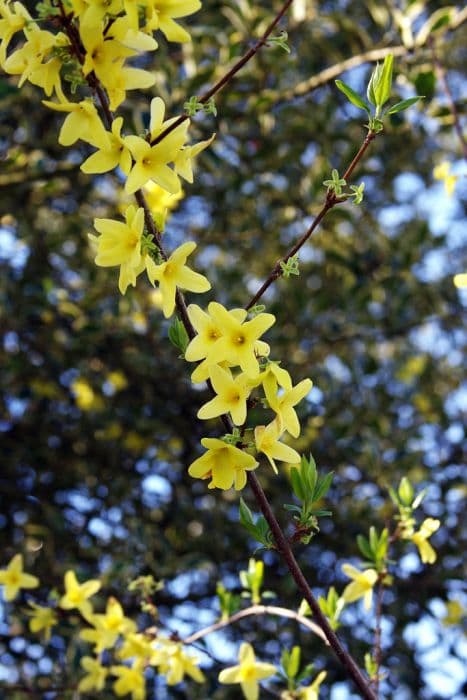Sweet Olive Osmanthus suavis
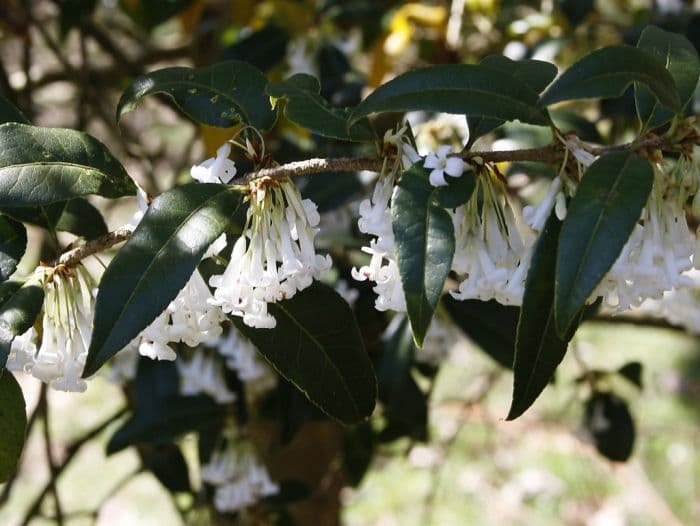
ABOUT
The plant known as Sweet Osmanthus is an evergreen shrub with a lush and dense growth habit. The leaves of Sweet Osmanthus are glossy, leathery, and dark green in color. They are generally oval-shaped and can be finely toothed or smooth-edged. As for the flowers, they are small yet notably fragrant, blossoming in clusters. The color of the blooms can vary from white to pale yellow, and they typically appear in the fall. The fragrance of the flowers is sweet and has been described as reminiscent of apricots or peaches. Following the flowering period, Sweet Osmanthus may produce small, bluish-black fruits. Overall, the appearance of Sweet Osmanthus is quite attractive, making it a popular choice for ornamental use in gardens and landscapes where it is appreciated for both its visual beauty and delightful scent.
About this plant
 Names
NamesSynonyms
Sweet Osmanthus, Fragrant Olive, Sweet Olive, Tea Olive.
Common names
Osmanthus suavis.
 Toxicity
ToxicityTo humans
Osmanthus suavis, commonly known as Sweet Osmanthus, is not widely recognized for its toxicity to humans. There is limited information available suggesting that this plant poses a significant health risk when touched or ingested. However, as with any plant, individual allergies and sensitivities can occur. If any symptoms of an allergic reaction or poisoning appear after contact or ingestion, such as skin irritation, difficulty breathing, or digestive discomfort, seek medical attention.
To pets
Sweet Osmanthus is not commonly known to be toxic to pets. However, individual animals may have different sensitivities or allergic reactions. It is always a good practice to prevent pets from ingesting plants. If a pet ingests part of a Sweet Osmanthus and shows signs of distress or illness – such as vomiting, diarrhea, drooling, or changes in behavior – it is important to consult a veterinarian.
 Characteristics
CharacteristicsLife cycle
Perennials
Foliage type
Evergreen
Color of leaves
Green
Flower color
White
Height
10-15 feet (3-4.5 meters)
Spread
6-8 feet (1.8-2.4 meters)
Plant type
Shrub
Hardiness zones
7
Native area
China
Benefits
 General Benefits
General Benefits- Aesthetic Appeal: Sweet Osmanthus offers attractive foliage and fragrant flowers, enhancing garden beauty and providing visual pleasure.
- Landscape Versatility: Can be used in a variety of landscape designs, including hedges, screen plantings, and as a standout specimen.
- Wildlife Attraction: The plant's flowers attract pollinators such as bees, which are beneficial for the garden ecosystem.
- Low Maintenance: Generally requires minimal care once established, making it ideal for gardeners seeking low-maintenance plants.
- Drought Tolerance: Once established, Sweet Osmanthus exhibits a degree of drought resistance, reducing the need for frequent watering.
- Cultural Significance: In some cultures, the fragrance of Sweet Osmanthus is celebrated and used in festivals, adding cultural depth to its planting.
 Medical Properties
Medical PropertiesThis plant is not used for medical purposes.
 Air-purifying Qualities
Air-purifying QualitiesThis plant is not specifically known for air purifying qualities.
 Other Uses
Other Uses- **Culinary ingredient**: Osmanthus suavis is a flavoring agent, particularly the flowers, which can be used to infuse teas, confections, and liquors with a distinctive apricot-like aroma.
- **Essential oils**: The flowers can be processed to extract essential oils for use in perfumery and aromatherapy.
- **Cosmetics**: Osmanthus extract is occasionally used in high-end skincare products for its purported soothing properties and fragrance.
- **Cultural significance**: In some cultures, the plant is associated with good luck and is used in festive decorations or given as a gift during special occasions.
- **Garden landscaping**: Due to its attractive appearance and pleasant scent, Sweet osmanthus is a popular choice for ornamental gardening and landscape design.
- **Floral crafts**: Dried osmanthus flowers are sometimes used in potpourri or sachets to impart fragrance to linen and clothing storage areas.
- **Symbolism**: In the language of flowers, Osmanthus suavis is often associated with romance and is sometimes used in wedding bouquets and decorations.
- **Insect repellent**: Like many fragrant plants, the sweet osmanthus is believed to naturally deter certain insects from the garden area where it is planted.
- **Art inspiration**: The plant's aesthetics inspire artists and can be found depicted in a variety of art forms, such as painting and poetry.
- **Photography**: Its striking blooms make it a favorite subject for photographers, particularly those specializing in botanical and nature photography.
Interesting Facts
 Feng Shui
Feng ShuiSweet Osmanthus is not used in Feng Shui practice.
 Zodiac Sign Compitability
Zodiac Sign CompitabilitySweet Osmanthus is not used in astrology practice.
 Plant Symbolism
Plant Symbolism- Romance: The sweet fragrance of Osmanthus is often associated with love and romance, making it a symbol of amorous feelings and attractions.
- Good Fortune: In some cultures, Osmanthus is believed to bring good luck and is often used in festivals and celebrations as a token of good fortune.
- Nobility: The elegant nature of the plant, along with its delightful scent, can signify nobility, refinement, and dignity.
- Peace: Osmanthus can represent peace and tranquility, embodying a spirit of harmony and calm.
 Water
WaterSweet Osmanthus requires consistent moisture and should be watered when the top inch of soil feels dry to the touch. An average guideline is to provide about 1 gallon of water per week, but this can vary depending on climate, soil, and plant size. In hotter, drier periods, it may require watering twice a week. Ensure that you water deeply and directly at the soil level to encourage deep root growth, and avoid shallow sprinkling which can promote weak root development. During winter, reduce watering to prevent overwatering as the plant's growth slows down.
 Light
LightSweet Osmanthus thrives in full to partial sunlight. Best results are typically seen when the plant receives at least 4-6 hours of direct sunlight per day. Placing it in a location that gets morning sun but is shielded from the intense afternoon rays can prevent potential leaf scorch, while still providing ample light for healthy growth.
 Temperature
TemperatureSweet Osmanthus is hardy and can handle a range of temperatures; it grows best between 60°F and 80°F. It can survive minimum temperatures down to about 10°F, but sustained cold or frost below this threshold can cause damage. Ideal conditions for this plant include warm days and cooler nights, as it can enhance flowering.
 Pruning
PruningPruning Sweet Osmanthus promotes healthy growth, maintains its desired shape, and can enhance flowering. Prune in late winter or early spring before new growth begins. Deadheading, or the removal of spent flowers, can be done as needed. Thinning out old branches every few years encourages new shoots to develop.
 Cleaning
CleaningAs needed
 Soil
SoilSweet Osmanthus prefers well-draining soil with a mix of compost and sand, ensuring good aeration. The ideal soil pH for Sweet Osmanthus is slightly acidic to neutral, around 6.0 to 7.5.
 Repotting
RepottingSweet Osmanthus should be repotted every 2 to 3 years or when it outgrows its current pot to prevent root bounding and to replenish the soil nutrients.
 Humidity & Misting
Humidity & MistingSweet Osmanthus thrives best in moderate to high humidity levels, around 50 to 80%, which simulate its natural environment.
 Suitable locations
Suitable locationsIndoor
Place Sweet Osmanthus in bright, indirect light with some direct sun.
Outdoor
Plant in partial shade, protect from strong winds, mulch well.
Hardiness zone
7-9 USDA
 Life cycle
Life cycleOsmanthus suavis, commonly known as Sweet Osmanthus or Sweet Olive, begins its life cycle as a seed, typically dispersed by wind or animals. Upon germination, which requires well-drained soil and adequate warmth, a seedling emerges and over time develops into a small sapling. As the sapling matures into a young plant, it requires plenty of sunlight and regular watering to establish a robust root system. As a mature shrub, Sweet Osmanthus produces fragrant white flowers in the spring, which are pollinated by insects, leading to the formation of seeds enclosed in small fruits. The plant will continue to flower annually, contributing to seed dispersal and new generation propagation. Sweet Osmanthus is a perennial and can live for many years, continuing its cycle of growth, flowering, and seed production.
 Propogation
PropogationPropogation time
Spring to Summer
The most popular method of propagating Osmanthus suavis, commonly known as sweet osmanthus, is through semi-hardwood cuttings. This process is typically done in late summer. To propagate by cuttings, a gardener would select a semi-hardwood stem from the current season's growth that has started to mature but is not yet fully woody. Cutting lengths of about 4 to 6 inches (10 to 15 cm) are taken, and the lower leaves are removed to expose a few nodes. The cut end may be dipped in rooting hormone to encourage root development before being planted into a mix of sand and peat or a similar rooting medium. The cutting should be kept moist and in a warm, indirect light until roots have developed, which can take several weeks. After rooting, the new osmanthus plant can be transplanted to a more permanent location in the garden.
